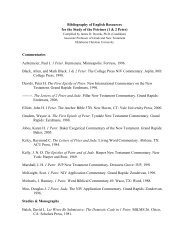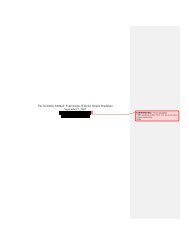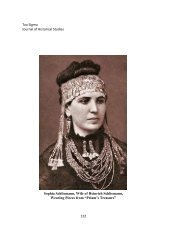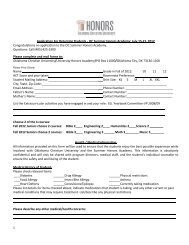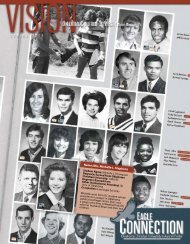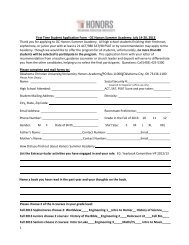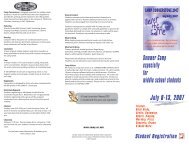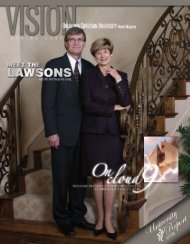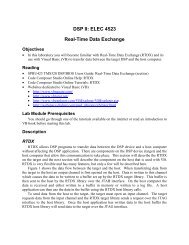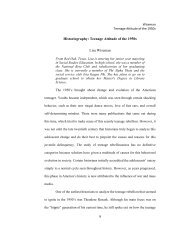Teacher Work Sample revised 8 24 2011-1
Teacher Work Sample revised 8 24 2011-1
Teacher Work Sample revised 8 24 2011-1
You also want an ePaper? Increase the reach of your titles
YUMPU automatically turns print PDFs into web optimized ePapers that Google loves.
Lesson Plans: Provide a copy of all lesson plans designed for your TWSYou must address several questions when constructing a response for each section. Each section is furtherdescribed below.4
6Participant ID: _______________________________________FACTOR 1 CONTEXTUAL INFORMATIONStandard: The teacher uses information about the learning/teaching context and student individualdifferences to set learning goals, plan instruction, and assess learning.Checklist: <strong>Teacher</strong> describes: N YNumber of Students............................................................................................................... 0 1Ethnic, Cultural and Gender Make-up.................................................................................. 0 1Socio-economic Status (SES) Make-up................................................................................ 0 1Classroom Environment........................................................................................................ 0 1Community Environment...................................................................................................... 0 1Students with Special Needs................................................................................................. 0 1Describe developmental characteristics of students (intellectual, social, physical)……….. 0 1Total Checklist Score: _____/ 7Rubric:A. Instructional Implications--The degree to which the teacher candidate specifically describesand uses contextual information to plan and describe instruction.0Standard NotMet1Standard Partially Met2Standard MetXScorePriorKnowledgeand SkillsEvidence ofusing priorknowledgeand skills isnot present.Evidence of using prior knowledgeand skills is present, but decisionsexhibit a monocular perspective (i.e.,teaching one way to all).Evidence that the teacher recognizesthe variance of beginningknowledge/skills levels in the classand engages in compensatoryactivities related to the lessonobjectives (e.g., does more to definewords in a vocabulary unit forstudents with deficits incomprehension).2 /4Specificity<strong>Teacher</strong> doesnot addressimplicationsof contextualinformation inplanninginstruction andassessment.<strong>Teacher</strong> addresses implications ofcontext for instruction and assessmentbut does not link to specific studentindividual differences andcommunity, school and classroomcharacteristics.<strong>Teacher</strong> addresses implications ofcontext for instruction andassessment and links them to specificstudent individual differences andcommunity, school and classroomcharacteristics.2 /4(Evaluator comments may be made on the back of this page)Total Rubric Score: ____/ 8Total Score for Factor 1: ____/ 15
7Factor 2:Unit Learning Goals and ObjectivesList and describe all your unit learning objectives for this instructional sequence. Use higherlevel objectives when possible. 2/3 of your objectives should be higher level. Remember, yourlesson objectives should be clearly stated, developmentally appropriate, aligned with OklahomaPASS Objectives and/or district standards and described in terms of pupil performance – NOTactivities. Illustrate (show) the alignment between your objectives and national, Oklahoma PASSObjectives and/or district goals.Include a description of subject matter your students will gain if your unit learning objectives aremet.Example: 5 th Grade Math(Description of what 5 th grade students will gain in subject matter knowledge, skills, andreasoning ability if the unit learning objectives are met.)Standard 3: Geometry – The student will apply geometric properties and relationships.1. Compare and contrast the basic characteristics of circle and polygons (triangles,quadrilaterals, pentagons, hexagons, heptagons, octagons).2. Classify angles (e.g.: acute, right, obtuse, straight)Content Knowledge Objectives1. Students will name 8 out of 10 geometric shapes. (PASS 3.1) (Knowledge/Remember)2. Students will name 4 attributes about each shape. (PASS 3.1)(Comprehension/Understanding)Skill/Performance Objectives3. Students will correctly classify triangles into categories with 80% accuracy. (PASS 3.2)(Application/Applying)Reasoning Objectives4. Students will compare and contrast the basic polygons citing 4 similarities and 4differences. (PASS 3.1) (Analysis/Analyzing)5. Students will create polygons given a specific set of criteria with 80% accuracy. (PASS3.1) (Synthesis/Creating)
10Type ofAssessmentsLearning ObjectivesFactor 3: Assessment Plan TableFormat of Assessment1. Pre Assessment2. FormativeAssessment(Use additionalspaces as neededto list assessmentsused.)4. PostAssessmentSubmit a clean copy of your assessment(s) and scoring criteria (e.g., keys, rubrics, etc.) asAttachment #1.[Suggested total page length for the Assessment Plan: 2 Pages]
11FACTOR 3 ASSESSMENT PLANStandard: The teacher uses multiple assessment modes and approaches aligned with learning goals to assess student learning before, during andafter instruction. The teacher uses on-going analysis of student learning to make instructional decisions.Checklist: The <strong>Teacher</strong>: N YExplains and defends choice of assessment as relevant to development level and content.....…………......... 0 1Uses identical pre-post assessments………................................................................................……………. 0 1Explains how assessment instructions are understandable to ALL students..........….................................….. 0 1Assessment adaptations are made for Special Needs students ………………………....……………….…… 0 1Employs formative assessments congruent with pre/post tests...……..……………............………………… 0 1Total Checklist Score:_______/ 5Rubric:A. Assessment Plan and Assessment Quality--The degree to which students use pre-assessment results to guide instruction and the degree to whichtheir assessments are challenging, match stated objectives and are comprised of multiple formats (e.g., are not all multiple choice questions).0Standard Not Met1Standard Partially Met2Standard MetX ScoreAssessmentFormatThe assessment planincludes only oneassessment format.The assessment plan includesmultiple formats but all formats areeither pencil/paper based (i.e., theyare not performance assessments)and/or do not require the integrationof knowledge, skills and reasoningability.The assessment plan includes multiple assessmentformats including either performance assessments ortasks which require integration of knowledge, skillsand reasoning ability. 2 /4AssessmentPlanNo description ofassessment plan.Response includes only 1 or 2 of thecriteria listed to the right.The assessment(s) specifically addresses each of theobjectives.The plan demonstrates the use of assessmentthroughout the instructional sequence.Assessment format matches the condition specified inthe objectives.2 /4AssessmentChallengeThe assessment isoverly easy (e.g.,requires only simpleresponses, givesanswers away, easy toguess, etc.) or toodifficult.The assessment is not uniformlychallenging.The assessment is challenging.(e.g., tasks are not simplistic, test can discriminatebetween students who attain the outcome and thosethat cannot. Students should not be able to answercorrectly if they have missed class, not paid attention,guessed, etc.)2 /4AssessmentCriteriaNo evidence.Response includes only 1 or 2 of thecriteria listed to the right.Measurable-all criteria for assessment are described inmeasurable terms.(e.g., not “performance” “activity” “worksheet” asdescriptive criteria).Comprehensive-Covers essential content and skillsfrom all those covered during instruction. Does notassess irrelevant content and skills.Criterial Level-Specifies the point at which studentssuccessfully meet the attainment of the learningobjective.Total Rubric Score: ____/ 16(Evaluator comments may be made on the back of this page) Total Score for Factor 3: ____/ 212 /44.Administrative purposes only: The assessment(s) used in this sample include the following formats (check all that apply):___T/F ___Short Answer ___Performance Assessment and Rubric___Listing ___Essay ___Matching ___Other (specify):_______________________
12Factor 4:Instructional DesignA. Pre-Assessment Analysis Provide a graphic representation of your pre-assessment data within the text of this section. What did you learn about the prior knowledge/skills/abilities of the students in your class asindividuals and as a whole based on your pre-assessment data? Disaggregation of Data: What did you learn about the selected subgroups of students (e.g.,students who perform similarly on the pre-assessment)? Cite specific evidence from theassessment data that led you to these conclusions about the class and about the subgroups ofstudents. How did your analysis of the pre-assessment data influence how you designed the learningactivities for your class as a whole? For the students in your subgroups? Be specific.[Suggested total page length for the Pre-Assessment Analysis: 1 page not including attachments]B. Instructional Design TableProvide an Instructional Design Table outlining your instructional design for the unit in theorder you plan to present the instructional activities. (You may create the table using landscapepage formatting if wider columns are needed.)Instructional Design TableTime Learning Objectives Instructional Activities Assessment(s)Day 1Day 2Day 3Day 4
13C. Instructional Design Plan Why were the activities sequenced in this way? Discuss how the instruction addressed different learning strategies. Address use ofGardner’s multiple intelligences and/or learning styles. How did you encourage students’ use of critical thinking, problem solving, andperformance? Explain your use of best practices to promote positive social interaction, selfmotivation,and active engagement in learning. Provide evidence of group work(assigned and self-selected). What communication techniques are used to foster active inquiry, collaboration, andsupportive classroom interaction? How was technology (e.g., audio-video, overhead, computers, calculators, adaptive,etc.) integrated into your activities? Describe your instructional resources and why you included them. How did your actual implementation of the instruction differ from your original designfor instruction? Explain the reasons for modifications (if any) of your original design forinstruction. Include changes in your use of instructional resources. What feedback did you give to students based on your analysis of their work? Refer toyour written comments on the students’ work and explain any other form of feedbackyou gave to students. Include evidence for checking for understanding.[Suggested total page length for the Instructional Design: 5 pages]
15MotivationalelementsAll activities, topics, etc. arepre-planned by the teacherwith no procedures includedfor giving studentsresponsibility for thelearning success of the unit.Motivation strategies arebased on external rewardsand punishments only.Students are given someresponsibility for their ownlearning. <strong>Teacher</strong> maintainscontrol of the vast majority ofchoices. Most strategies arebased on extrinsic motivationalprocedures.Procedures for giving studentsresponsibility for their own learningare pervasive. The unit ischallenging and includes proceduresthat promote student self-direction,accountability, and collaborationwith others (e.g., students’ interestsare incorporated, students set goals,initiate topics, and/or self-assess)1 /2TechnologyInstructional design does notinclude technology or arationale for the exclusion oftechnology.Technology is used without dueregard to learning outcomes(i.e., it is just an add-on tofulfill the requirement).Technology is integrated throughoutinstruction or makes a meaningfulcontribution to learning (i.e., it had apurpose or was needed) or aninstructionally sound rationale isgiven for the exclusion oftechnology.1 /2Total Rubric Score:Total Score for Factor 4:____/12____/18
17FACTOR 5 ANALYSIS OF LEARNING RESULTSChecklist: The <strong>Teacher</strong>: N YPresents graphics and data that are easily read and interpreted........................................... 0 1Uses narrative which reflects the degree of learning students demonstratedduring the classroom activities compared to assessment results.............................. 0 1Includes accurate calculations of gain scores in a completed worksheet............................. 0 1Has covered and assessed all learning objectives in the availableinstructional time frame...................................................................................…… 0 1A. Rubric: Analysis of Learning ResultsTotal Checklist Score: ____/ 40Standard Not Met1Standard Partially Met2StandardXScoreAnalysis oflearningThe teacher provides nodata on the achievementof individual learningobjectivesorThe teacher provideswhole-group achievementdata only.The teacher providesevidence of achievement forsub-groups, whole-groupsand for individual studentsbut does not provideevidence on the degree thateach met individualoutcomes/objectives.The teacher evaluates how eachindividual and subgroup (identified incontextual and pre-assessmentanalysis) has performed on eachobjective/outcome (i.e. the teacherprovides evidence that they knowboth the “who” and “what” in: “whogot what” and “who didn’t get what’).2 /4Total Rubric Score:_____/4Total Score for Factor 5: ____/ 8
18Factor 6:Reflection on Teaching and LearningYou should address the following topics within your reflection:A. Interpretation of student learning: Conclusions made about the extent to which each of the learning goals were met. Explain the greatest barriers to achieving learning results.B. Insights on best practices and assessments as related to students: Student motivation and behavior to create learning environment. Student social interaction and self-motivation. Active engagement of student learning.C. Alignment of learning goals with assessment data: Connect learning goals, instruction, and assessment with assessment data.D. Implications for future teaching: Identify two successful activities or learning experiences and explore reasons for theirsuccess. (Cite theorist.) Identify two activities needing strengthening, modification, etc., and explain yourrationale.E. Implications for professional development: Reflect on your own abilities and identify what professional knowledge, skills, ordispositions (e.g., attitudes, values, and beliefs) would improve your performance inteaching this unit. Select and discuss your most significant learning insight from teaching this unit. Describe your plan for meeting your professional goals. (Cite a workshop or class.Be specific.)[Suggested total page length for Reflection on Teaching and Learning: 4 pages]
19FACTOR 6 REFLECTION ON TEACHING AND LEARNINGRubric0Standard Not Met1Standard Partially Met2Standard MetX ScoreInterpretationof StudentLearningNo evidence orreasons provided tosupport conclusionsdrawn in Analysis ofStudent Learningsection.Provides evidence but no reasonsor hypotheses (or they aresimplistic, superficial), to supportconclusions drawn in Αnalysis ofStudent Learning section.Uses evidence to support conclusionsdrawn in Analysis of Student Learningsection. Explores multiple hypotheses forwhy some students or sub-groups did notmeet specific learning goals.2 /4Insights onBest PracticesandAssessmentsProvides no rationalefor why someactivities orassessments weremore successful thanothers.Identifies successful andunsuccessful activities orassessments and superficiallyexplores reasons for their successor lack thereof (no use of theoryor research).Identifies successful and unsuccessfulactivities and assessments and providesplausible reasons (based on theory orresearch) for their success or lack thereof.2 /4Alignment ofLearningGoals,InstructionwithAssessmentDiscussion shows noalignment amonggoals, instruction, andassessment results.Discussion displays some senseof alignment, butmisunderstanding or conceptualgaps are present.Discussion connects learning goals,effective instruction and assessmentresults. 2 /4Implicationsfor FutureTeachingProvides no ideas orinappropriate ideas forredesigninginstruction.Provides ideas for redesigninginstruction but offers no rationalefor why these changes wouldimprove student learning.Provides ideas for redesigning instructionand explains why these modificationswould improve student learning. (Cites atheorist.)2 /4ImplicationsforProfessionalDevelopmentProvides noprofessional learninggoals or inappropriatelearning goals.Presents professional learninggoals, which are either vague ornot strongly related to the insightsand experiences described in thissection.Presents professional learning goals thatclearly emerge from the insights andexperiences described in this section.Describes plans for meeting these goals.(Cites a workshop.)2 /4(Evaluator comments may be made on the back of this page)Total Score for Factor 6: ____/ 20
Cover Page20Oklahoma <strong>Teacher</strong> <strong>Work</strong> <strong>Sample</strong>:Analysis of Student LearningResident <strong>Teacher</strong>’s Name: ___________________________________________________Date Submitted:Name of School:Content Area:Grade:TWS Number:_____________________________________________________________________________________________________________________________________________________________________ (to be filled in by Staff)



